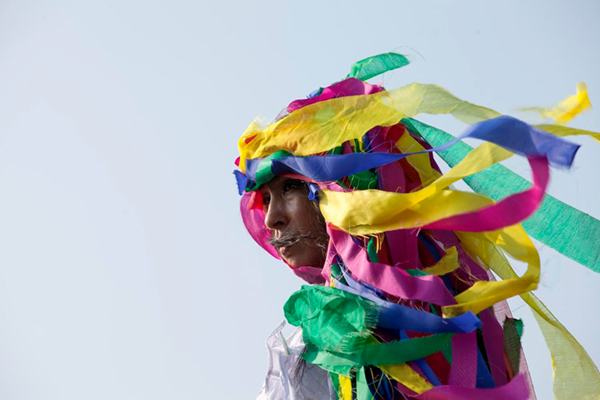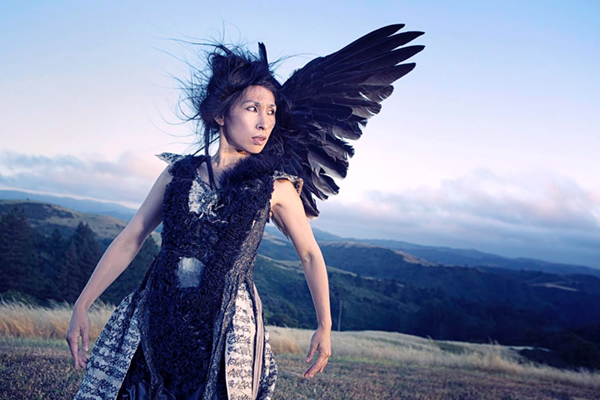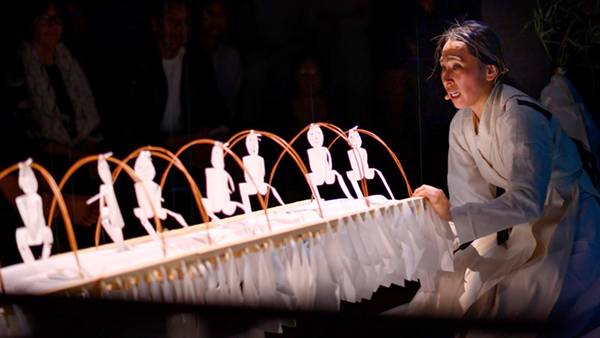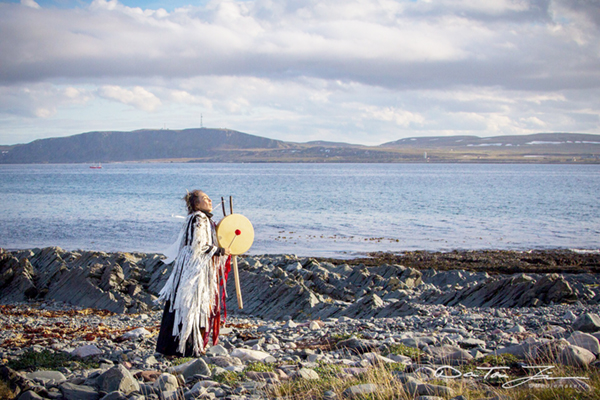Ritual and Connection
An Interview with Dohee Lee
BY EMMALY WIEDERHOLT
Dohee Lee is a Korean dance artist living in Oakland, CA who creates ritual performance by combining her training in ancient shamanic ritual practices with post-modern performance styles and electronics. Here, she discusses her approach to making dances and how it is rooted in community, especially her most recent piece, Mu, which explores themes of connection.
Photo by Yongye Yu
~~
Can you tell me a little about your dance history – what kinds of performance practices and in what contexts shaped who you are today?
My training is Korean traditional dance and music. I studied in Korea. That’s my foundation. When we look at traditional Korean music and dance, it’s rooted in Korean Indigenous practice. People call this shamanism. I relate to that approach.
Coming to the United States, I had a lot of curiosity and interest in interdisciplinary and experimental art. I combined the contemporary view of creating art with my Korean traditions. That became my practice. I bring my training from Korea, but I’m no longer in Korea; I’m in the United States. There’s a diasporic aspect of my work, expressing through different eyes my experience in the US. My work has lots of combinations of traditional forms but, at the same time, it’s a new way of looking visually and physically.
Meeting my mentor, Anna Halprin, also influenced how I look at art. Thinking about art as ritual was in my mind, but it really made sense after I met Anna: How we use art to transform how we see life. So, it’s not just about the art. It’s about interacting with life.
I bring my own curiosity and compassion to study identity, history and mythology. I’ve done a lot of projects that relate to mythology, working alongside community members to support and facilitate how they can bring out their own stories and cultures into the creative process.
Photo by Pak Han
How would you generally describe your work to someone unfamiliar with it?
My work is interdisciplinary; it has drumming, electronic music, singing, visual art and projection along with the dance to help tell the story. There’s a visual quality using lights and costumes. I use all of that to create a ritual. I always call my performance a ritual. When you see ritual in other cultures, you see a lot of singing, drumming, food and costumes – all those are in my art. When people see performance ritual, all those elements are there. Then I ask: What’s the message I want to convey or the story I want to address?
Can you tell me about your current piece, Mu, and its guiding themes or concepts?
Mu literally means connector. How I approached making Mu is thinking about how time is connected – past to present, and how that links to the future. I’m also integrating the mythology of my own country, Korea. I’m using the island mythology and ritual practice as a container for inviting different communities to share their stories. I work with local people based in Oakland, thinking about Oakland as a village and working with the villagers. I asked them: How do we bring back a spiritual practice or an ancient practice or our ancestor’s practice? I’m meeting local communities individually and sharing what’s going on in their lives or in their communities, confronting what needs to be spoken and asked. Specifically, I’ve been meeting with a refugee youth group whose ancestors are originally from Nepal but migrated through Bhutan long ago and were expelled from Bhutan into refugee camps. For young folks born into refugee camps, what is the meaning of home? What is identity? I’m creating with this youth group to bring out their stories and how to deliver those stories into the art form.
Another group I’m working with is Korean drummers. All of them are into activism, so we talk about the history of Korea as it relates to justice for the Indigenous people. There are many connections: How do we connect to our history and how does that connect to the issues we have today? In order to understand what is going on now, we must look back at history. We need to stay empowered to keep digging by integrating mythology, because mythology is a wisdom. We work together with this wisdom to bring out creativity to work on what is happening in our lives through the art.
Photo by Scott Tsuchitani
What does your choreographic process look like, either more generally or specific to Mu?
We spend a long time getting to know each other. One group I’ve been working with for more than three years. Community work is not about sometimes going over there to work with them. I dedicate my time to knowing their lives. It takes three to five years of working together and taking the time to build their trust so I’m not a stranger.
We talk about what is happening and the issues arising in their communities. We find common challenges. From there, we start a process of writing and, from the writing, we express with our bodies. That’s our basic practice. From the sharing, we express our voices through movement or writing so we tell our stories. The choreography becomes a combination of talking and moving. One person might share their story while some movement is happening around them. I want to create enough time for them to really share their feelings and stories.
For Mu, I’m working with 40 people from four different communities. Sometimes, an artist goes into a community, hears some stories, and then makes their own piece. My intention is different; it’s for them to speak their own stories by their own bodies. As an artist, how can I give that space and time? How do I share space with people who need to express what is going on in their lives?
Mu is three to five hours long, and the performances are at different local cultural events in parks. Next year in May, I’m restaging it at the Yerba Buena Center for the Arts.
What do you hope audiences take away from Mu?
I want people to experience coming into this outdoor durational ritual and really experiencing why we need the ritual, what the ritual looks like, and what these people are confronting in their lives. I want them to be participants, not just separate witnesses. I want to embrace everyone to share the space together.
I not only want to share these people’s stories but also remember our ancestors. This piece has a very important quality of honoring ancestral connections, both remembering the ancestral lands that we left and honoring the Ohlone land that we live on now.
Photo by Dan Tore Jorgensen
~~
To learn more, visit www.doheelee.com.




